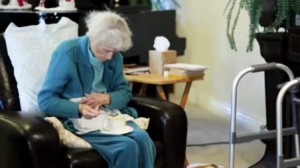Glenfield Hospital.
Could a memory wall and a memory box help people with dementia? Find out about the simple but brilliant idea here.
On the face of it it seems a brilliant idea and I would be very interested in finding out what our readers thought about the memory wall! You may also find this interview with Dr Nori Graham who is Medical Director of Red and Yellow Care, Vice President of Alzheimer’s Disease International and The Alzheimer’s Society a useful introduction to the whole area of dementia and Alzheimer’s.
The wall contains a selection of old photographs which have been donated by the Leicester Mercury is at Glenfield Hospital’s ward 33a. The pictures are on display for patients’ enjoyment as they move around the cardiology ward.
Vanessa Struthers, who is ward clerk for Leicester’s Hospitals for 23 years, came up with the idea. She said: “It started off with old photos of Leicestershire but as the collection has grown, we’ve included iconic photos from key historical events, such as the Queen’s visit to Leicester.”
Struthers worked with people on the ward to create the display, which aims to help those admitted to the ward. She commented : “We thought it was important that our patients chose the pictures, so the wall is made up of their memories. It’s really fascinating to see all these wonderful pictures on display in one single place.”
Thanks to a kind donation from the family of a former patient, the team at Glenfield have also been able to purchase a memory box. It contains various items from days gone by, which are recognisable through touch or smell, such as carbolic soap, moth balls and a dolly peg.
Using memory boxes with elderly patients has been shown to help stimulate and focus their minds as they have very vivid memories of their past, but can struggle to retain short term memories due to Alzheimer’s or dementia.
Struthers said : “We have had a fantastic response to both the memory wall and the box. We are so grateful for the donations which have enabled us to provide these for our patients.”
Your chance to discuss the future of Leicester’s Hospitals
Members of the public are invited to find out more about how local hospital services are changing over the next five years at University Hospitals of Leicester NHS Trust’s upcoming Annual Public Meeting 2014.
With a theme of ‘The future of Leicester’s Hospitals’, this year’s meeting will be held at The Big Shed at Freemen’s Common on Tuesday, 9 September from 4pm – 8pm.
From 4pm – 6pm, members of the public are welcome to browse an information fair where they can talk to staff and learn more about our services and the plans for the future at the Royal Infirmary, Leicester General Hospital and Glenfield Hospital.
Karl Mayes, Membership and Public & Patient Involvement Manager at Leicester’s Hospitals explains: “As a new feature this year, our chief nurse Rachel Overfield and her team will be holding a Listening Event alongside the information fair from 4pm – 6pm.
“This is a great chance for those who have recently used Leicester’s Hospitals to speak privately in a quiet area of the venue before the main meeting starts. Rachel and her team are keen to hear all experiences, both good and bad.”
Refreshments and a light buffet will be available for attendees before the formal meeting begins at 6.30pm, during which the Trust Board will review the past year and discuss our new Five Year Plan, Better Care Together. Members of the public will also have the chance to put questions to chief executive, John Adler and the Board of Directors.
Everyone is welcome with no booking required and parking is free at the venue. If you would like any further information or directions to the venue, please contact Karl.Mayes@uhl-tr.nhs.uk or visit www.leicestershospitals.nhs.uk/apm-2014
Extra Corporeal Membrane Oxygenation – What is it and why might you need to know about it! A must read for any heart or lung patients
As this is the occasion of the 25th anniversary of the introduction of Extra Corporeal Membrane Oxygenation to the Uk I thought it would be a great idea to introduce it to my readers in some more detail!
Extra Corporeal Membrane Oxygenation is used when a patient has a critical condition that prevents the lungs or heart from working normally. An ECMO machine is very similar to heart and lung machines used during open-heart surgery. It is a supportive measure which uses an artificial lung (the membrane) to oxygenate the blood outside the body (extracorporeal).
The treatment was developed in the USA by Robert H Bartlett MD, with the first successful ECMO treatment for an adult taking place in California in 1971, followed by the first neonatal survivor in 1975.
In 1989, having been inspired and convinced of its merits, ECMO was introduced to the UK by paediatric surgeons, Richard Firmin and Andrzej Sosnowski, both based at Groby Road Hospital (now Glenfield Hospital).
At this time, the value of ECMO was not recognised by the NHS so it was unwilling to fund the new treatment. Mr Firmin approached local charity, Heart Link to consider fundraising for the £200,000 set up cost of this pioneering treatment. Heart Link was convinced of its potential benefits and an appeal was launched.
Since then thousands of babies, children and adults lives have been saved by this technique, including 21-year-old James Mulholland who was only six-weeks-old when he underwent the treatment.
In February 1993, newborn James was suffering with bronchial pneumonia. His consultant, Dr Mike Hocking at Selly Oak hospital in Birmingham had little hope of him surviving, until he read about ECMO treatment at Glenfield.
James was transferred and put on ECMO for six days, until his lungs had recovered enough for him to breathe on his own.
James’ mother, Joanne Mulholland, explained: “To look at him now you would never believe what he went through. He is nearly 6 foot, fit and healthy and loves going to the gym and playing sports. His lungs work perfectly.”
Joanne added, “James would not be here today without ECMO. I will be forever grateful to all the staff at Glenfield who took such good care of him.”
Today, Glenfield remains the UK’s largest and most successful ECMO programme, which was publicly commended for its work during the swine flu epidemic in 2009. It is currently the only UK centre to provide paediatric mobile ECMO, by which the team travel to other centres, stabilise patients on ECMO and then transfer them to appropriate centres for ongoing care. The centre is also one of five in the UK to provide adult mobile ECMO, although Glenfield was the first.
Healthcare, Social Media and People Power – How patients are helping to find a cure for a rare heart condition called Spontaneous Coronary Artery Dissection (SCAD)
Rebecca Breslin, 36, from Melton Mowbray in Leicestershire, was struck down in March 2012 by spontaneous coronary artery dissection (SCAD) – a condition that results from an abnormality in the coronary artery causing the lining of the wall to tear resulting in a heart attack. Despite her diagnosis, her condition is so rare that cardiologists were unable to answer many of her questions and so she took to the internet to find more information.
She discovered just one research project in the world into the condition run by the Mayo Clinic in Massachusetts, USA.
As part of the US study, the research team were trying to establish a virtual registry of SCAD patients. Keen to share her case, Rebecca joined this registry but also saw the potential for other researchers to collaborate with this study, so she also began searching for other British female patients with the hope of establishing a project here in the UK.
Thanks to her efforts in identifying more than 100 patients from the UK, and a further 80 internationally, a grant from the British Heart Foundation (BHF) is now funding a two year study into the condition. The study will be undertaken by a team of researchers at the NIHR Leicester Cardiovascular Biomedical Research Unit, part of the University of Leicester, based at Glenfield Hospital.
Rebecca said: “This is a great example of people power. SCAD is a devastating condition; some sufferers have been left with heart failure and in other cases, sadly it’s proven fatal. We need answers as to why this happens to people and we hope this project will deliver on that. I’m delighted that we as patients have been able to get this off the ground.”
Dr David Adlam, cardiologist at Leicester’s Hospitals and lead researcher for the project, added: “This situation is unique. We usually struggle to find patients for our studies but this is a highly motivated group of patients who are understandably committed to finding out why this has happened to them and what it means for them and other people in the future.
“What we currently know about SCAD is largely anecdotal. The grant from the BHF will allow us to provide information based on solid science to the medical community and patients, improving diagnosis and management of the condition for patients in the future.”
SCAD is known to affect mostly women and in the majority of cases occurs in women under 50 who are otherwise healthy. In a significant number of cases, the condition occurs around the time of pregnancy or recently after giving birth.
Senior Cardiac Nurse at the BHF, Maureen Talbot explains: “Thankfully this condition is rare. But it can have devastating consequences – particularly in younger women who’ve probably never thought about their heart health before. We hope this research will help to understand this condition better, so we can develop better treatments for it and perhaps even prevent it in the first place.
“In the meantime, if you’re a woman and you’re worried or curious about your heart health, you can visit our Women’s Room – a dedicated online hub full of practical information and where you can talk to other women, just like you. Just visit www.bhf.org.uk/women.”
Patients with this condition can also register their interest in the research program on the SCAD-UK/EU website http://scad.lcbru.le.ac.uk/ or visit http://www.bhf.org.uk/publications/view-publication.aspx?ps=1002532 for further information on SCAD.



